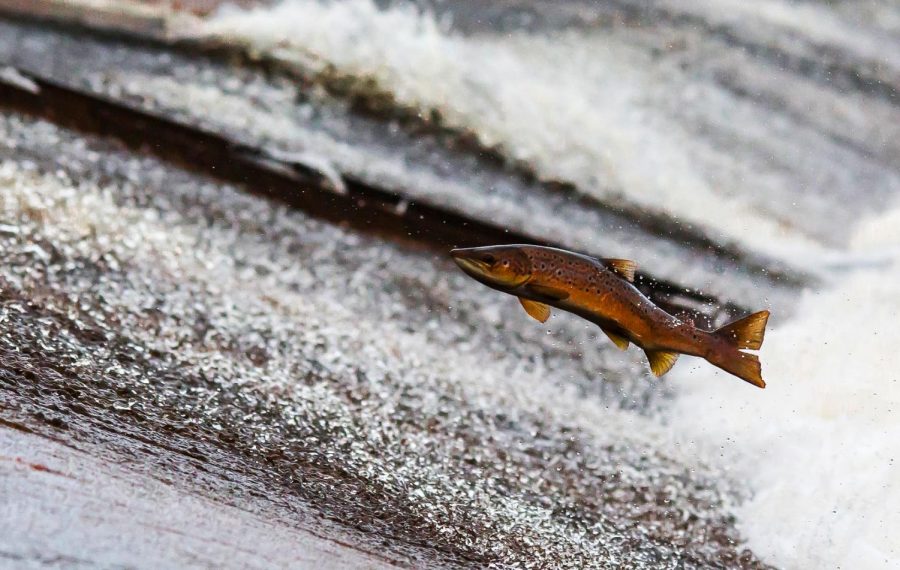WSU researcher looks to find solution to fish mortality
A single source is not yet determined, but car tires may be partially to blame
Certain types of fish, including coho salmon, are more adversely affected by urban water runoff than others. Researchers are trying to find out why.
October 8, 2018
A WSU researcher is studying how urban stormwater runoff affects fish health.
Jenifer McIntyre, assistant professor at the Washington Stormwater Center in Puyallup, Washington, is working with the National Oceanic and Atmospheric Administration Fisheries and the U.S. Fish and Wildlife Services.
Recent findings show specific fish species react differently to urban runoff, which is a problem for certain fish but not others. Researchers are trying to see how many coho and chum salmon survive to spawn.
Once coho salmon are exposed to urban runoff, they die in a few hours, but chum salmon do not get sick or die. Researchers are not sure why this discrepancy occurs.
“Coho are at risk where we build cities,” McIntyre said.
This is because coho live in lowland areas and do not spawn very far upstream, she said. There are high mortality rates for coho salmon due to urban stormwater runoff because they commonly spawn in creeks near cities.
If coho salmon are not surviving to spawn, there are fewer salmon eggs, McIntyre said. That means fewer salmon are born, which could affect the food chain. This includes the Puget Sound orcas, which commonly feed on coho.
So far, the research has been in the Puget Sound Basin, but researchers plan to do studies outside of the area because the problem has been happening north and south of the their study sites as well.
Beyond coho and chum salmon, researchers have been studying herring and surf smelt near the shore.
“Adults come up to beaches to spawn and we’ve been able to get eggs from them and do the experiments in the lab,” McIntyre said.
Studies found that when fish such as coho are growing in an eggshell, they are more protected from chemicals, but still show adverse effects. The researchers have been checking to see if their embryos are developing.
“The coho when they did hatch out were smaller,” McIntyre said.
A new website and app will allow people to help scientists with this research. It teaches how to identify a specific type of salmon, its sex, how to measure its length and how to report a dead salmon.
“When these fish come back to spawn, it’s the fact that we find the females still full of eggs that lets us know that there’s a problem,” McIntyre said. “It’s harder to tell with males if they’ve spawned because they can spawn a little or they can spawn a lot. With females, within a day or two, they get rid of all their eggs.”
Researchers want to know what it is in the runoff that causes fish to die and are doing field studies and laboratory experiments which expose coho to urban runoff.
“We have measured metals that are dissolved in water,” McIntyre said. “[We have] measured temperature and pH and dissolved oxygen levels. If those are off, they’re definitely going to die.”
Despite these preliminary findings, researchers still do not know exactly what is causing the problem from urban runoff.
They have also added metal and hydrocarbons to the water, but that did not cause the fish to get sick or die, McIntyre said.
The researchers also tested whether particles from tires that wash off roads in the rain could be causing the problem.
“We’ve been approaching it from a sources perspective,” she said. “Of the things we’ve looked at, the tires are the most suspicious.”
Tire particles seem to be one of the biggest risk factors, but researchers are still not certain it is the cause, McIntyre said. They do not know if it is only one or two things that are causing more fish to die, or many factors together.
One part of the solution to urban stormwater runoff is green stormwater infrastructure such as rain gardens, permeable pavement or green roofs, she said.
“We try to stop the stormwater, try to soak [it] into the ground if possible, get it to be filtered,” McIntyre said. “The idea is that it will more slowly enter into a stream or into the Puget Sound.”















